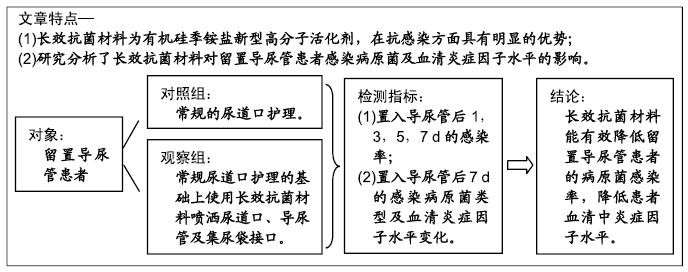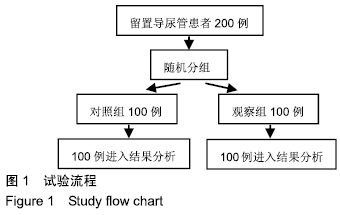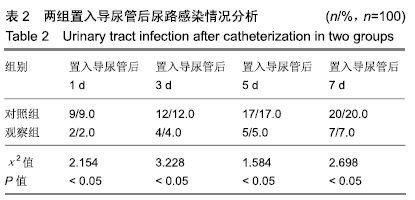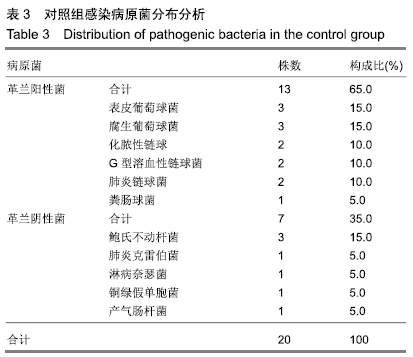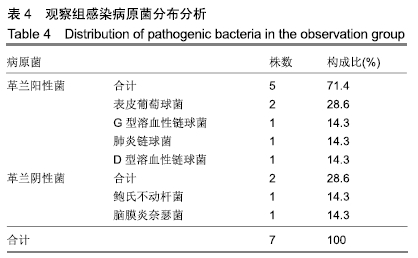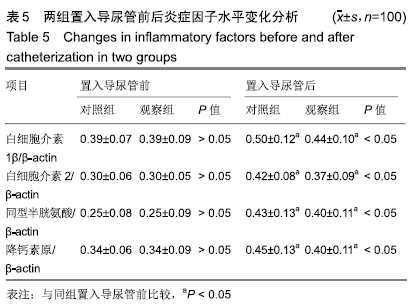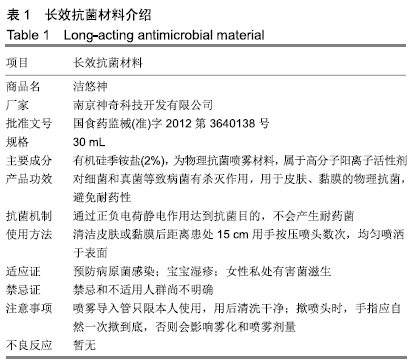[1] 魏楠,王力红,赵霞,等.老年患者导尿管相关尿路感染风险预测评分模型构建与验证[J].中国感染控制杂志,2018,17(10): 907-912.
[2] 余黎静,胡小叶,王科平,等.患儿留置导尿管尿路感染的病原菌特点、危险因素分析及护理预防[J].中国卫生检验杂志,2018, 28(18):2252-2254.
[3] GUNDLAPALLI AV, DIVITA G, REDD A, et al.Detecting the presence of an indwelling urinary catheter and urinary symptoms in hospitalized patients using natural language processing.J Biomed Inform. 2017;7(1):SS39-S45.
[4] BOND SE, BOUTLIS CS, JANSEN SG, et al.Discontinuation of peri-operative gentamicin use for indwelling urinary catheter manipulation in orthopaedic surgery.ANZ J Surg. 2017;87(11):E199-E203.
[5] 韩玲样,孙庆芬,曹煜隆.尿道口清洁消毒方法预防导尿管相关尿路感染效果的贝叶斯网状Meta分析[J].中国消毒学杂志,2018, 35(9):659-662.
[6] 胡艳香,耿红梅.泌尿外科术后患者留置导尿尿路感染的护理干预对策[J].实用临床护理学电子杂志,2018,3(35):87,92.
[7] UMER A, SHAPIRO DS, HUGHES C, et al.The use of an indwelling catheter protocol to reduce rates of postoperative urinary tract infections.Conn Med.2016;80(4):197-203.
[8] REUVERS S, ZONNEVELD W, MEILAND-VAN BAKEL M, et al. Indwelling urinary catheter-related problems after laparoscopic radical prostatectomy.J Wound Ostomy Continence Nurs.2016;43(4):420-424.
[9] 郑奋薇,蔡桂程,梁美莲,等.重症患者导管相关性尿路感染危险因素分析[J].解放军医学院学报,2018,39(6):494-497.
[10] PAUL AB, SIMMS L, PAUL AE, et al.A rare cause of death in a woman: Iatrogenic bladder rupture in a patient with an indwelling foley catheter.Urol Case Rep.2016;6:30-32.
[11] MURUGAN K, SELVANAYAKI K, AL-SOHAIBANI S.Urinary catheter indwelling clinical pathogen biofilm formation, exopolysaccharide characterization and their growth influencing parameters. Saudi J Biol Sci.2016;23(1):150-159.
[12] 金艳,武俊,张亚芳,等.抗菌材料洁悠神在预防针道感染中的运用[J].北方药学,2016,13(9):193-194.
[13] 黄晓哲,刘雪娥,王玲,等.洁悠神预防重症脑卒中患者留置尿管尿路感染的效果观察[J].护士进修杂志,2019,34(1):83-84.
[14] 陈奖国,杨明莹,李丹娜,等.洁悠神预防留置导尿伴尿路感染的meta分析[J].当代护士(中旬刊),2018,25(11):1-4.
[15] KATO K, MATSUMURA Y, YAMAMOTO M, et al.Erratum to: Seasonal trend and clinical presentation of bacillus cereus bloodstream infection: Association with summer and indwelling catheter.Eur J Clin Microbiol Infect Dis. 2016; 35(5):875-883.
[16] KANDADAI P, DUENAS-GARCIA OF, PILZECK AL, et al.A randomized controlled trial of patient-controlled valve catheter and indwelling foley catheter for short-term bladder drainage. Female Pelvic Med Reconstr Surg.2016;22(2):88-92.
[17] HAK CC, SIVAKUMAR P, AHMED L. Safety of indwelling pleural catheter use in patients undergoing chemotherapy: A five-year retrospective evaluation.BMC Pulm Med. 2016; 16(41):445-449.
[18] GU X, ZHANG Y, CHENG M, et al.Management of non-ovarian cancer malignant ascites through indwelling catheter drainage.BMC Palliat Care.2016;15(44):1239-1244.
[19] 叶乐荣,陈芳芳,江宝玉,等.黄连素药浴联合洁悠神喷洒治疗新生儿脓疱疮疗效观察[J].基层医学论坛,2018,22(28):4040-4041.
[20] 苏林,丁春,周永刚,等.长效抗菌材料雾化治疗呼吸道感染患者中的临床效果探讨[J].中国处方药,2018,16(9):63-64.
[21] 马佩芬,王东敏,张秀,等.长效物理抗菌材料应用于中心静脉导管相关性感染的有效性及安全性分析[J].中华医院感染学杂志, 2017,27(24):5592-5595.
[22] 蒋艳丽,滕雪梅.洁悠神在血液透析临时中心静脉置管中的应用[J].实用临床护理学电子杂志,2017,2(44):5,7.
[23] 南存金,苏红侠,何有华,等.外用抗菌剂洁悠神联合抗返流引流袋预防留置导尿伴随性尿路感染[J].中华全科医学,2016,14(4): 569-570.
[24] 苏红侠,南存金,周彬瑜,等.洁悠神预防留置导尿伴随性尿路感染的临床研究[J].中华全科医学,2015,13(2):299-301.
[25] 杨颜龙,张素敏,张红艳,等.夫西地酸乳膏联合长效抗菌材料洁悠神治疗儿童脓疱疮疗效观察[J].长江大学学报(自科版),2018, 15(16):39-40.
[26] 段彦霞,康利萍,陆少飞,等.洁悠神长效抗菌材料预防留置导尿管患者尿路感染效果观察[J].河南外科学杂志,2018,24(3): 181-182.
[27] 王晓阳,褚小玲,孙立元.复方多黏菌素B软膏联合长效抗菌材料洁悠神在尖锐湿疣光动力治疗术创面中的应用[J].中华实验和临床感染病杂志(电子版),2018,12(2):160-164.
[28] 蒋艳丽,滕雪梅.洁悠神在血液透析临时中心静脉置管中的应用[J].实用临床护理学电子杂志,2017,2(44):5-7.
[29] 李杰.洁悠神预防留置尿管性尿路感染的有效性观察[J].护士进修杂志,2016,31(18):1712-1713.
[30] 覃秋海,朱绍般,陈杰,等.洁悠神长效抗菌材料联合复方紫草油治疗烧伤创面的临床观察[J].中国临床新医学,2016,9(5):390-393.
[31] 操作亮,刘双林,袁劲东,等.膀胱癌患者术后尿路感染免疫状态与炎症介质[J].中华医院感染学杂志,2018,28(11):1697-1700.
[32] 曹译丹,刘鑫,王晓庆,等.头孢呋辛与左氧氟沙星治疗泌尿系统感染疗效观察及对炎症因子的影响[J].中华医院感染学杂志, 2018, 28(1):44-46.
[33] 阎蕾蕾,李黎明,田新亚,等.导尿管相关尿路感染炎症指标水平分析及护理措施探讨[J].河南医学研究,2017,26(23):4233-4236.
[34] 李旭升,郭长城.幽门螺杆菌感染对血脂、血清炎症因子的影响及其与冠心病的相关性[J].实验与检验医学,2017,35(6):940-942.
[35] 谢鸿.幽门螺杆菌感染与血清炎症因子及Hcy水平相关性研究[J].临床消化病杂志,2017,29(3):144-146.
|
